Laws of the Jungle
| May 16, 2023Ari & Ari meet the Hebrew-speaking spiritual seekers of Ivory Coast

Ivory Coast is a deep African country mostly associated with elephant tusks and cocoa beans. So when we heard about a group of spirituality-seeking native Africans who’ve taken on Orthodox Jewish practice, built a shul, pray in Hebrew, and keep halachah to the best of their knowledge, it was an invitation we couldn’t refuse
Conjure up a country that characterizes deep, dark Africa, and you might come up with the former French colony called Côte d’Ivoire, or Ivory Coast. Located at the bottom of Africa’s western land extension with its southern border on the Atlantic Ocean, the country is full of impenetrable rain forests that are home to monkeys and baboons, snakes and panthers. Although Ivory Coast is named for the former lucrative ivory trade, today there are few elephants left in these parts (although another huge mammal, the blue whale, can be seen off its coast). But while tusks are no longer making traders rich, the country is known as the cocoa bean capital of the world. (And isn’t that easier than chasing down a herd of elephants?)
This relatively small country, about half the size of Texas, produces over 2,000,000 tons of cocoa beans annually, about 40% of the world’s entire production. Yet while its economy is growing, most natives live in poverty — with life expectancy in the 40s and infant mortality more than 100 per 1000 live births.
Now, we like chocolate as much as the next person, but cocoa beans alone wouldn’t be enough to get us here: Instead, we came to meet an emerging Jewish-affiliated community, one of several that have been popping up — seemingly out of nowhere — all over the African continent over the last years. But we couldn’t help wondering why would native Africans, so culturally far from the Masoretic tradition, choose this foreign lifestyle with all the restrictions and historical challenges it entails?
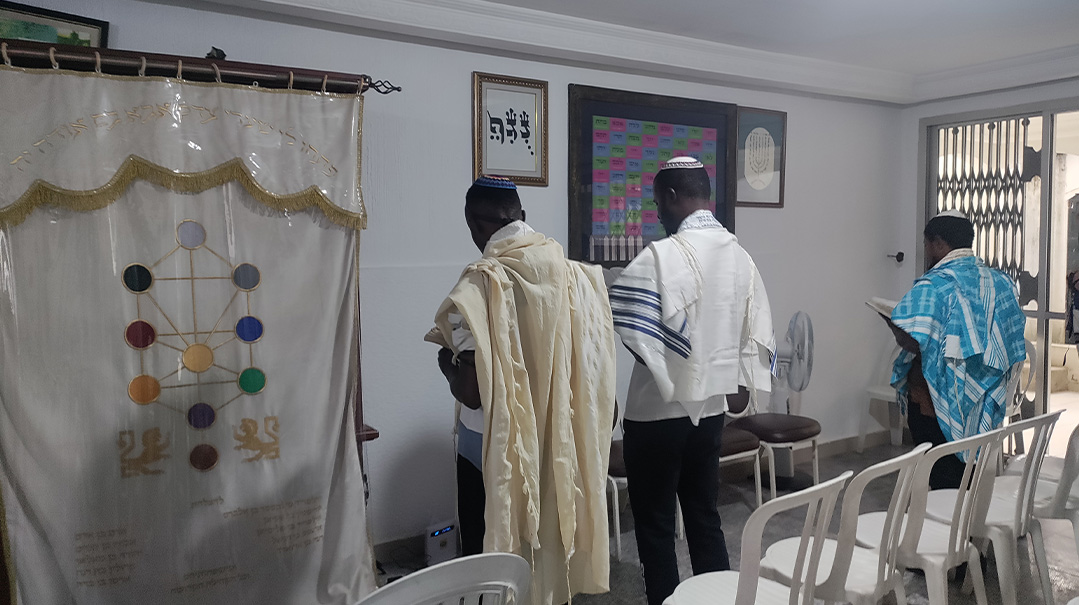
One Giant Step
Our contact on the ground was Professor Yehuda (Firmin) Ahoua, who’s been leading Ivory Coast’s small Jewish-practicing community since 2001, consisting of both local people and occasional Israeli visitors (for whom, ironically, it’s sometimes their first religious connection). We spoke to Yehuda before we arrived and asked him what we could bring him. His answer was instant and revealing: “We need two platot for Shabbat and a hot water urn — these items can’t be found here.” Well, after hearing that, we knew one thing: This group wanted to operate within the boundaries of halachah. We were curious to understand how that happened, considering there has never been an organized Jewish presence in the country.
After many hours of traveling, we landed in Abidjan, the country’s largest city, its administrative center, and home to most foreign embassies. Waiting for us was a delegation from the local community, headed by a fellow named Akiva, a man in his late 60s who was wearing a kippah with tzitzis peeking out from under his shirt. There was no need to guess who we were, as not only were we the only travelers wearing those same Jewish signs, but we were also the only non-Africans on the flight.
Driving us to our hotel was another member of the community, General Michel Gueu, a retired four-star general. He had been a senior commander of the army of Ivory Coast (the second-highest ranking officer in the army after the Chief of Defense Staff), a former government minister, and was well-connected to the country’s leadership. It didn’t take us long to figure out that the particular kehillah we’d come to meet was made up of highly educated and successful people who had come to Jewish practice on their own after years of study and contemplation. In contrast to much of the country, this Cote d’Ivoire community is relatively affluent, much more so than other African communities, and counts among it doctors, dentists, professors, and diplomats. We met an army colonel who’s a pharmacist in civilian life, a wealthy international businessman, and the wife of the consul general of Côte d’Ivoire in Romania, among others.
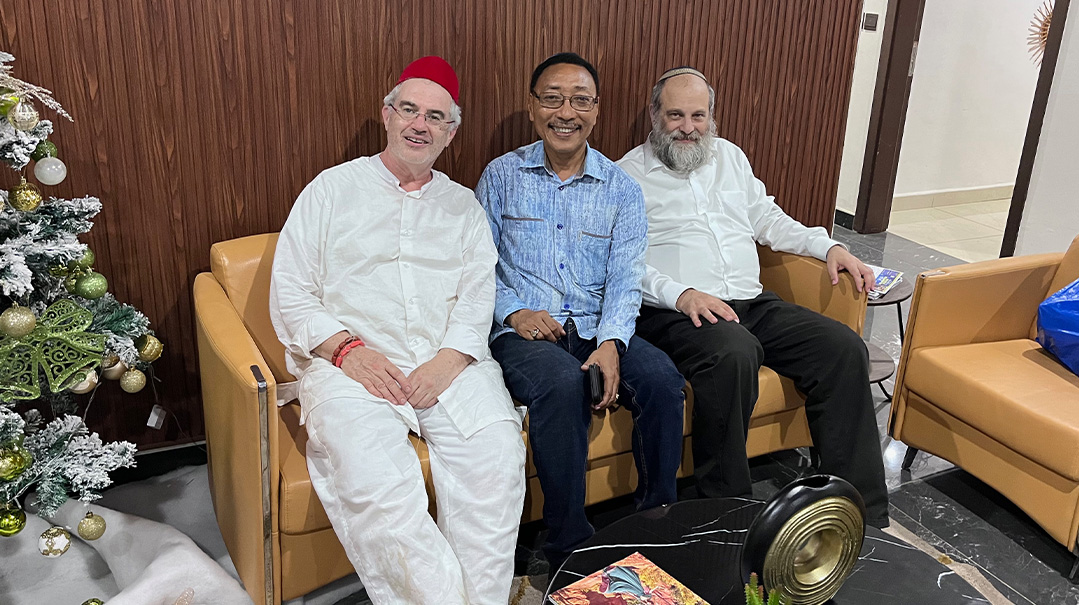
Ari G., Yehuda (Firmin) Ahoua, and Ari Z. in the hotel lobby in Abidjan. Others joined Yehuda on his spiritual journey, and it wasn’t long before he had a kehillah
So, what brings a group of educated and sophisticated people in Ivory Coast to embrace Orthodox Jewish practice? The moving force behind the group is our friend Dr. Ahoua, a professor of linguistics in Université Félix Houphouët-Boigny, the largest university in Côte d’Ivoire. He was born in Abidjan, acquired a master’s degree and PhD in Germany, and had a postdoctoral Fulbright Scholarship at the University of California at Berkeley. He has published numerous scholarly papers in international journals and has written several academic books. Dr. Ahoua is not only a linguist, but a polyglot — a native speaker of two local Kwa languages and perfectly fluent in French, German, and English. His background made our initial question all the more powerful: What led this highly educated African to Judaism?
True, his father’s first wife was Jewish, and that means he has Jewish half-siblings, living today in France. But he was on a deeper quest than a family connection.
Yehuda was on a spiritual journey looking for meaning in religion. He’d rejected Christianity, and, academic that he was, began to study Judaism in-depth. It began to speak to him, and he eventually decided to practice mitzvos and try to be a Jew. A small group of friends joined him, and like many other places in Africa, they opened a “synagogue.” Today the small group of religious devotees are shomrei Shabbos, learn Torah, and lead a religious lifestyle as best as they know how.
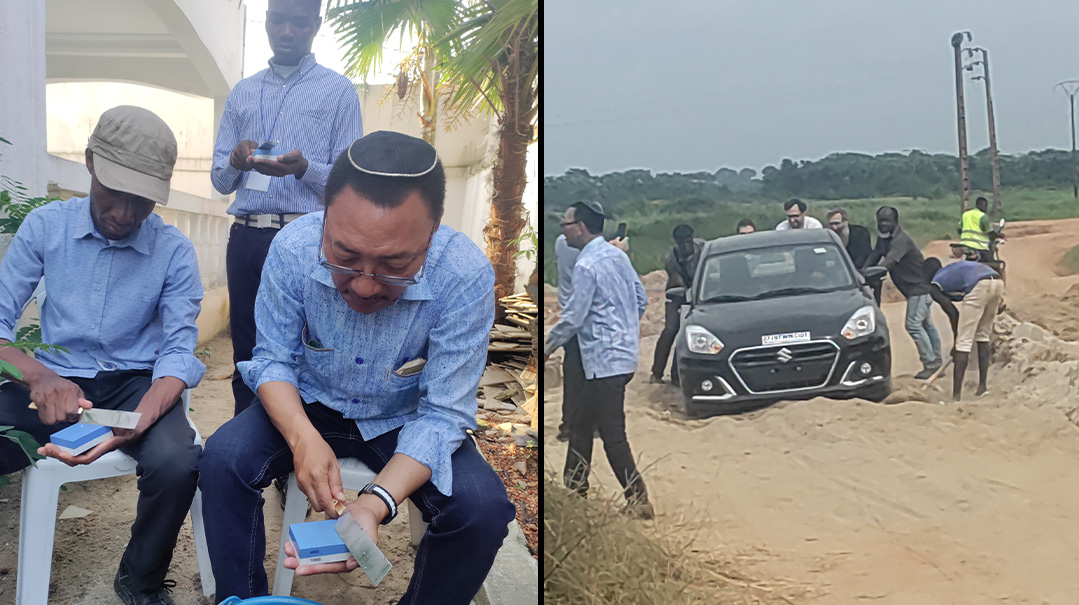
(Left) We filled in for the regular shochet, and gave Yehuda a lesson in sharpening a shechitah knife in the process
Have Knives, Will Travel
Yehuda has great dreams and visions for his community. While the current location of their synagogue, a rented house, is conveniently located and seems to be sufficiently large for their present needs, Yehuda dreams of much more. One of the members of the congregation, a building developer by the name of Ayemou Meir, donated a large tract of land to the community just outside of the city, in the Grand Bassam area. He has been active with the group for five years.
Yehuda envisions building a shul, mikveh, restaurant, Judaica shop, and homes for community members on that tract of land. While we were there, he requested that we hold a dedication ceremony. Never ones to miss a cultural opportunity, we piled into several vehicles, and after sitting in traffic on city roads for a while, we drove out of town and turned off onto unpaved, bumpy, muddy dirt paths. As we bounced up and down, Yehuda explained that this was actually good, because land with no paved access is cheaper, and as soon as the government paves it, the value of the land will increase manyfold. We hoped, for his sake, he was right, as the paths became so difficult that we all transferred to four-wheel drive vehicles to continue the journey on even less hospitable terrain. Finally, arriving at the location, we were surprised to see that despite the rustic setting, a tent had been set up with chairs and drinks in anticipation of a respectable event. There were even paramilitary troops present to ensure our safety, as we were far out of the protected city limits.
The ceremony consisted of the recitation of a few chapters of Tehillim, followed by words of praise for the generosity of the donor and wishes for the success of the project. Then a l’chayim was passed around as the kehillah broke out in song and dance.
It was fortunate that everyone was in such good spirits, because we had a bit of a mishap on the way back to the city after the ceremony. Soon after transferring out of the four-wheel drive vehicles, the mud won out: The tires spun but the vehicle didn’t budge… and so we all got out and pushed. It’s the closest you can get to being stuck in the snow when it’s 90 degrees and humid and you’re just a few kilometers from the equator.
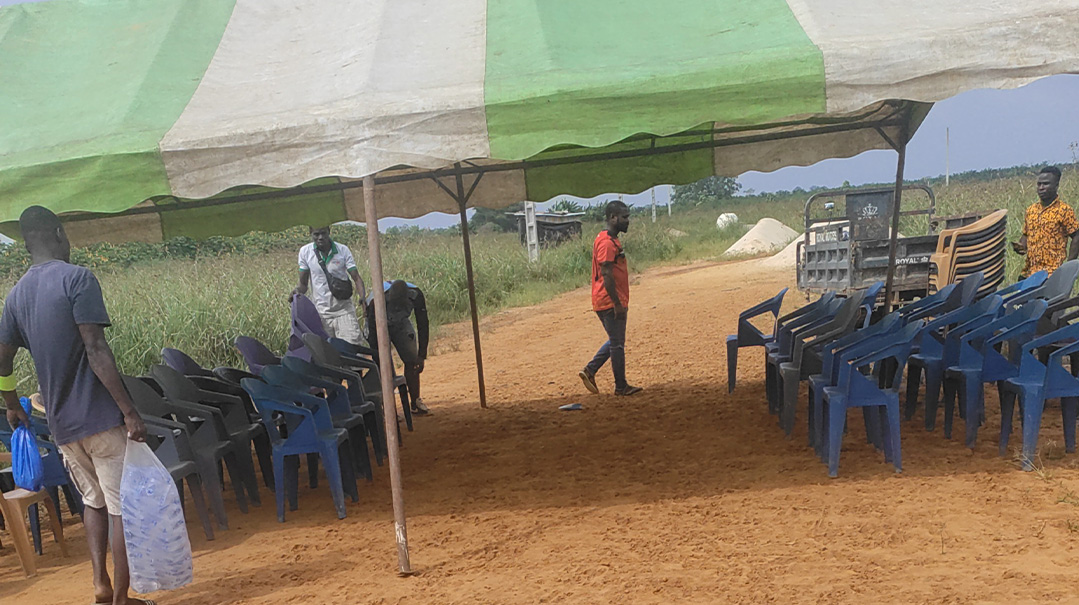
Yehuda’s dream location: The land is cheap because there’s no paved access (we know, because we got stuck in the mud), but that didn’t stop them from setting up an impressive ceremony in the wilderness
As a community policy, members of Professor Yehuda’s kehillah eat kosher meat, not a trivial achievement in Ivory Coast. They have gone to great lengths to procure the services of shochtim. At one point they would fly in and host the main shochet of the beis din of Casablanca and Marrakesh, Rabbi Isaak Amar, to shecht for them. After that, Rabbi Moshe Yetiv moved to the community and was their shochet for a short time. Then, about eight years ago, Ariel Palmon, a retired Israeli chazzan who knew how to shecht fowl began frequenting Abidjan. The community paid for him to go back to Israel and learn to shecht animals as well, and since then, he has been their regular source for kosher meat.
However, while we were there, Ariel was in Israel, and the community didn’t have any kosher birds or meat. Knowing this ahead of time, we packed our knives and stones, figuring they’d come in handy (as they often do when we venture into the unknown). Early on our first morning in Abidjan, we found ourselves in the backyard of the shul, slaughtering chickens. The experienced non-Jewish synagogue workers already had filled buckets with water to soak the fowl and had prepared grates upon which the birds were salted and kashered.
A little-known halachah is that kosher meat cannot be out of the eyesight of a Jew if it is not locked up or marked in a way that it can be identified. This is known as “basar shenisalem min ha’ayin” — which means that if you’re surrounded by non-Jewish workers, you need a mashgiach on site to be sure nothing was swapped in place of the kosher meat until the meat is locked up. In this environment, that was critical, and so we stayed with the meat until it was properly labeled and safely moved into the shul’s freezer. The shul has a dairy kitchen upstairs and a meat kitchen downstairs. They rarely have dairy as there is no kosher cheese in the country, so it is either chicken or pareve meals cooked in the meat kitchen.
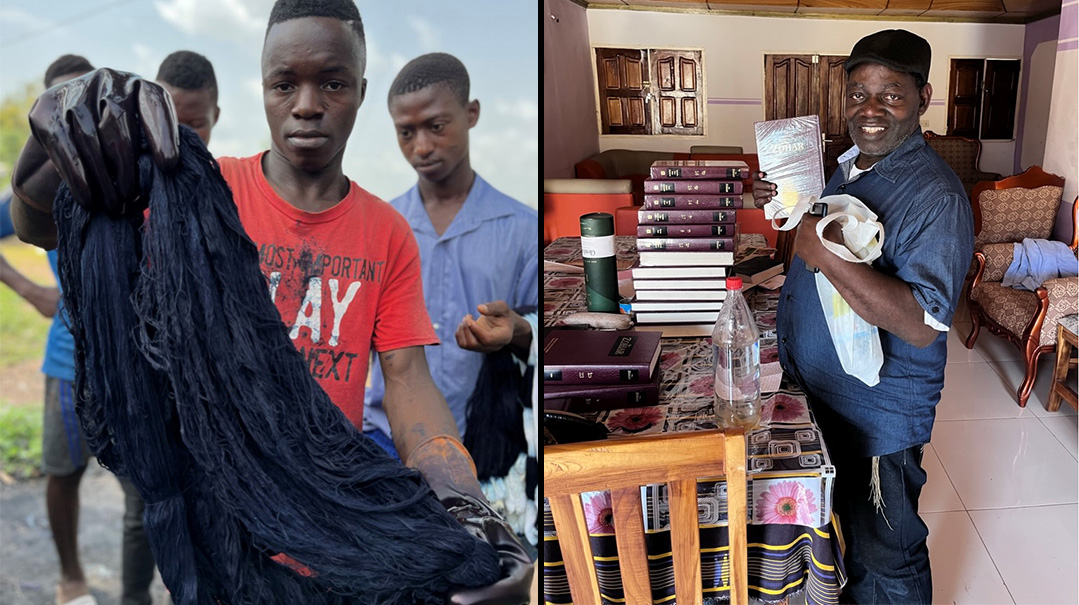
In a remote village in the African wilds, we discovered the “fake techeiles” Chazal referred to. We also discovered that a full set of Zohar in English can make its way to these parts
Dyed in the Wool
While researching Ivory Coast before our arrival, we learned that there is an indigenous indigo dyeing tradition. Indigo is a plant-based dye that is one of the most popular traditional dyes. It has been used for over 5,000 years and is the color of the ubiquitous blue jeans around the world. It also happens to be mentioned in the Talmud as the source of a dye indistinguishable from the blue techeiles strings of the tzitzis, but not acceptable for the mitzvah as its source is not from the chilazon snail. In its day, techeiles was worth many times its weight in gold, and the indigo dye, known in the Gemara as kala ilan, was cheap and easy to make. Unscrupulous dealers would fake the tzitzis with kala ilan but charge the high prices of real techeiles. In fact, the Gemara says this dye is so similar to techeiles that only Hashem can distinguish between it and the real thing.
Being that indigo dying today is all done commercially and with synthetic indigo, we jumped at the opportunity to visit an exceedingly rare traditional dye factory. It was deep inland and close to a six-hour drive away, which gave us an intimate view of the outlying landscape. We passed colorful African villages along the way, driving many miles of empty roads passing pecan orchards and cocoa plantations. Some villages had small roadside markets — rickety tables piled with fruits and vegetables and plastic bags filled with something that looked to us like farfel. When we inquired, we were told it was a pasta-like product extracted from the cassava plant. Many countries in Africa grow cassava, a long tuber vegetable that looks like a very fat, very long sweet potato. It’s the main source of starch for up to half a billion people worldwide, from South America to Asia. The cassava “pasta” is eaten daily by almost the entire population as the main starch in their diet.
Finally, we reached the dyers in a small village in the jungle. For the dye vats, they used cut open plastic jugs. Local boys took cotton strings and began the dye process, which requires dipping the cotton in the dye, squeezing it out, and exposing it to air, and then dipping it once again. Indigo-dyed cloth gets darker if it is dipped and then exposed to air many times. We worked together to dye strings, which was very similar to the process of dyeing techeiles. Once the strings are dry, they’re laid out in very long lines and will be put on a loom to weave cloth. The looms are primitive, made from tree branches, and barefoot kids work the foot pedals used in lifting the various strings to weave the garment. They had never seen Jews before and were quite enamored with our kippahs, and especially with the techeiles on our tzitzis. For us, it was fascinating to learn about the loom and the different melachos of Shabbos that relate to the process of weaving, which can really only be understood when you see a traditional loom in action. As we departed, the workers crowded around us and begged us to bless them before we left. Putting on his tallis, Ari G. raised his hands and wished them a long and healthy life.
We started our arduous journey back, but not before we stopped at Akiva’s house in the countryside for some drinks. While Akiva, a former customs officer who is today Shabbos observant, is part of the community in Abidjan, he actually has a free-standing house in the jungle many hours away and accompanied us on our excursion. Going off the highway, we came to a dirt road and found a nicely built house. Walking into his living room, we saw a stack of books on the table. Looking carefully, we realized it was an English translation of the entire Zohar. It was surreal that out in the jungle with not another Jew around for hundreds of miles, an entire set of Zohar was sitting on his dining room table.
On the way home we saw that our gas gauge was pointing low, but we had not seen a gas station for many miles, and we were getting concerned. We pulled off the highway next to a run-down village and were surprised to find a local Ivory Coast “gas station.” Piles of yellow jugs filled with gasoline were waiting to be bought. With no pumps, a funnel appeared, and the gas tank was filled by hand. We made it back after spending 18 hours on the road, but it was worth it to be able to visit one of the last places on earth that dyes cotton with indigo as in days of yore, and to see first-hand what “fake techeiles” Chazal was referring to. That was truly a halachic adventure.
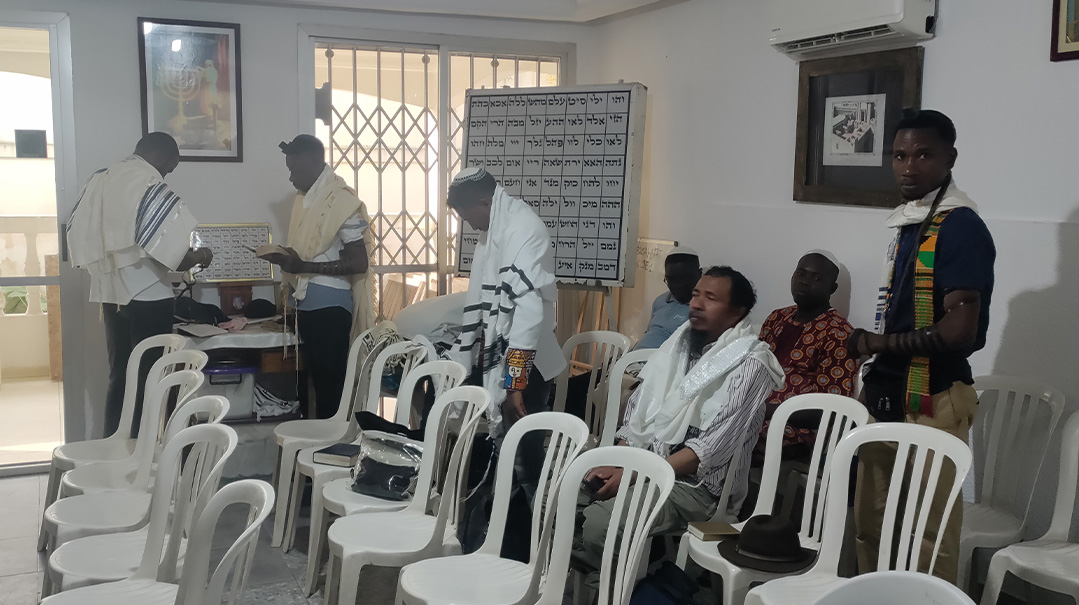
In the synagogue, infused with kabbalistic motifs, we were amazed at the proficiency of prayer and command of Hebrew
No Fear
The kehillah’s synagogue is in a villa behind high walls. While we were there, the temperature reached above 90 F° with almost 100% humidity. We were sweating buckets, only finding a bit of relief when powerful African rain showers dropped massive amounts of water, turning the dirt road in front of the building into a muddy quagmire.
As we tried to dodge the puddles, we entered the small synagogue, grateful for the AC. It was Thursday, and a small group of women were in the outside kitchen cooking and baking challah. We watched as they took challah with a brachah they read off a laminated card.
Most of the community participants live quite far from the synagogue, but the few who are fully Shabbos-observant sleep there over Shabbos. Never knowing what to expect from a prayer service in a community far from mainstream communities, we were amazed at their command of davening and Hebrew, and familiarity with many popular niggunim. The singing during the service was inspiring. During their Friday night dinner, we even challenged the chazzan to a Jewish music duel to see if we could start a song that they did not know. We were amazed by how many songs they knew.
Our hotel was a ten-minute walk away from the shul, so we were able to get a feel for the city. Right next to the hotel was the Chinese Embassy, housed in the city’s most modern building. Walking past that, the street morphed into an area of unfinished buildings, dirt paths, open air chicken grilling, and a large open drainage system along the side of the road. There were groups of African youths loitering around, and in a different place — think Harlem or the South Bronx — we might have feared for our lives. But we weren’t really nervous; Yehuda had assured us that although the US State Department has a level-3 alert regarding the country and advises reconsidering travel to Ivory Coast due to civil unrest and violent crime (“carjacking, robbery, and home invasion are common and are a main public security concern”), this part of the city, near the shul, is safe and crime-free. Indeed, people were friendly and gracious. Walking to shul Shabbos morning, we passed an outdoor betting shop sporting a chalkboard with odds for the World Cup. We were wearing our talleisim as there was no eiruv, and one of the bettors called out “Shalom” to us.

Although many of these “Breslovers” haven’t taken any initiative to convert to Judaism, they certainly walk the walk
Kosher-Style
Professor Ahoua’s group isn’t the only professed Jewish-affiliated group in this African country. There is a tribe in the north of the country who call themselves Danites. Large groups of indigenous peoples referred to as Danites claim they are descendants of the tribe of Dan and were part of the first exile close to 2,700 years ago. Although some members of the tribe have shown interest in traditional Jewish practices, they know no Hebrew nor do they have any fixed Jewish customs or traditions. However, they do wear a four-cornered garment that is a good replica of a tallis katan. They call it a “yacouba,” which sounds a lot like Yaakov.
The notion of the tribe of Dan having branches in Africa might have some veracity. In the ninth century, there was an itinerant Jewish African merchant and traveler by the name of Eldad the Danite. He spoke Hebrew with a smattering of an African tribal language and Arabic, and although probably originally from South Arabia, he professed to be from an East African community descended from the tribe of Dan, who made their way to Africa to “the land of the gold.” He traveled all the way to Bavel, and as a reputable philologist, was in fact quoted by the Raavad, Rashi and Rav Avraham, the son of the Rambam, in discussions of linguistic issues. There were also discussions among the Geonim and the Rishonim about differing halachos and chumros Eldad had, particularly regarding hilchos shechitah.
Yet despite some possibility of a connection between the Danites and the Tribe of Dan, our investigation seems to indicate otherwise. Professor Ahoua says there is no connection between their language and Hebrew, and other than a recent tiny group, the entire tribe does not see themselves as Jewish.
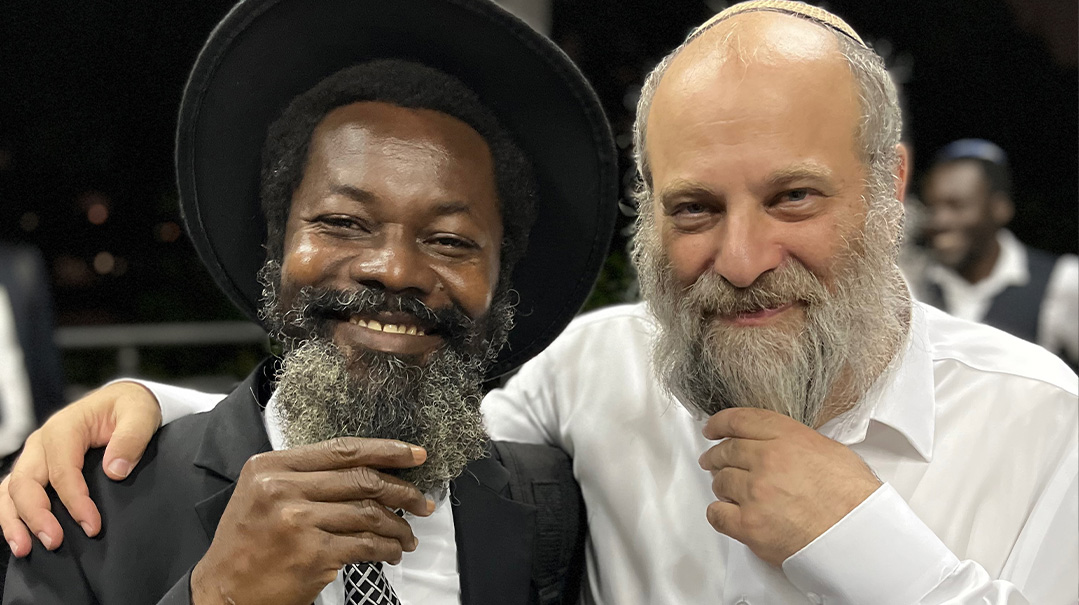
We’ve learned never to be surprised when it comes to Jewish identity in these parts. At a communal gathering right before we left, we spotted a group of fellows in black hats and yeshivish garb whom we hadn’t seen before. The only giveaway was their native visage. They told us they’d heard about us and wanted to meet us. When we asked them to tell us about themselves, they responded that they were “Breslovers.” Rebbe Nachman in the depths of Africa? But yes, they call themselves Breslovers, they live an hour’s drive from the community we were visiting, and they claim to be shomer mitzvos, although most have not gone through any kind of conversion process yet. We didn’t have a chance to visit their synagogue, but a friend of ours did on a later visit and reported that it was normative. He said they seemed to have Jewish knowledge and were both educated and financially successful.
They pulled up chairs around us to talk. When we meet these groups, we never really know what the story or their background is. Are they really practicing Judaism, despite the fact they are not Jewish? Are they messianic Christians who are masquerading as Jews? Sometimes by discussing with them and evaluating their knowledge, we can get a sense of what they are like and what motivates them. So we asked them if they could sing a song from davening, and sure enough, they all belted out a version of Lecha Dodi. Yet despite some knowledge and practice, they grew out of Christianity, and although they’ve rejected that religion, only a few have taken the initiative to begin a conversion route. We would have liked to have spent more time with these “Breslovers of the Jungle” and hear more about their journey — perhaps on a future halachic adventure to the region.
Having already provided kosher esrog seedlings and aravah cuttings to three communities in Africa on our previous trips, we now brought along a Yemenite esrog and some additional aravah cuttings. You never know where you might meet somebody who can use them. We cut up the esrog and passed out the seeds. Where exactly in Africa will they sprout? We can’t be sure, but if the trend continues, there will surely be some groups out there who will appreciate the opportunity for the mitzvah.
(Originally featured in Mishpacha, Issue 961)
Oops! We could not locate your form.







